
November 2009
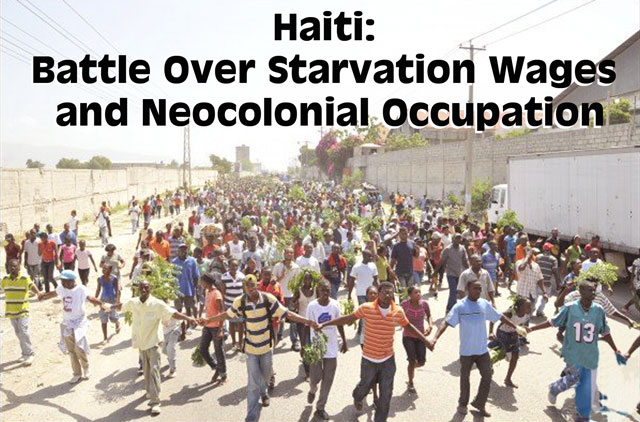
200 gourde ($5) daily minimum wage. Photo: François Louis/Le Nouvelliste
Haiti,
home of the first successful slave revolution in history, has for most
of
its independent history been condemned by the workings of the
capitalist system
to a threadbare existence of grinding poverty. Decades of economic
blockade of
the black Caribbean republic by the United States and the European
colonial
powers in the 19th century were followed by repeated occupations by
U.S. troops
and rule by U.S. puppet dictators in the 20th. Throughout, the
impoverished
country has been prevented from developing indigenous industry. Today
Haitian
agriculture has been ruined by the importation of subsidized rice from
Louisiana in the name of “free trade.” As the island nation reels under
the
“natural” disaster of annual hurricanes, any protest is put down by
“United
Nations” occupation forces acting as mercenaries for U.S. imperialism,
which
has its hands full in Iraq and Afghanistan.
For
years, the only images of Haiti have been of sheer desperation:
garbage-strewn
slums and rickety boats of fleeing refugees. But Haiti does have a
working
class, notably in garment factories in several “free trade zones,” and
in
August these workers fought an important battle against starvation
wages. In
May, both houses of the Haitian parliament voted to raise the legal
minimum
wage to 200 gourdes (roughly $5) a day, from the previous 70 gourdes
($1.75).
Even 200 gourdes is barely one-third of the daily minimum costs for
food,
shelter, clothing, transportation and education for a family of three,
and
below the U.N. definition of poverty ($2 per person per day). But
leading
businessmen declared that paying that miserable sum would drive them
into bankruptcy
and threatened to shut down half the factories in the country.
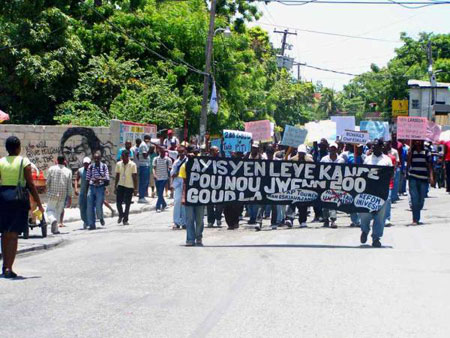
Demonstration for 200 gourde minimum wage
denounces repression byh MINUSTAH troops, August 2009.
(Photo: anarkismo.net)
Haitian
president René Préval took up the bosses’ lament,
demanding that legislators
repeal their earlier action. As the vote drew near, workers streamed
out of
plants in the industrial parks of the
capital, Port-au-Prince, to march on parliament. In a peaceful
demonstration of
hundreds on August 4, protesters complained: “70 gourdes won’t allow us
to live
decently. We can’t afford to eat on our wages. If we are sick, we can’t
go to
the hospital. We work from 6 a.m. to 7 p.m.” (AlterPresse, 4
August). After a parliamentary committee voted to
slash the 200 gourde minimum to 150, thousands of angry workers took to
the
streets August 5. On August 10, protests turned violent as workers and
students
responded to police tear gas by stoning official vehicles and the car
of the
U.S. chargé d’affairs, who sought refuge in a police station
besieged by
demonstrators. On August 11, after four walkouts in one week, the
bosses
decreed a lockout at the SONAPI industrial park, whose plants employ
14,000
workers.
Finally,
on August 18, the pliant deputies and senators saluted their capitalist
masters
and slashed the legal minimum to 125 gourdes (a little over $3) a day.
It was a
bitter defeat for the workers in the first organized class mobilization
under
the U.N. occupation. In 2008, as the cost of rice and other staples
rose by 50
percent, hunger riots that began in the provinces and spread to the
capital
were put down by the MINUSTAH (United Nations Stabilization Mission in
Haiti)
military and police forces with a toll of several dead. But those were
largely
spontaneous acts of despair by impoverished slum dwellers. In the
recent
marches workers used their strength to shut down production. Though the
outcome
was a setback, it was a battle that could lead to more powerful and
conscious
working-class struggle in the future. The key is revolutionary
leadership.
Many
workers drew lessons about the country’s rulers. One remarked: “It’s
sad to see
that the president of the republic chooses to defend the interests of
the
bourgeoisie rather than ours.” Some showed an awareness of their own
power,
dismissing the bosses’ threats: “They need us.... If they say their
factories
will close their doors it’s false.” Demonstrators trampled on the flags
of the
different countries whose troops make up the MINUSTAH, saying “These
are the
flags of occupation.” This was also the first time under the occupation
that
workers have been joined by students, who since the beginning of the
year have
occupied the National Teachers College and different faculties
(ethnology, law
and medicine) of Haiti’s State University (UEH). This shows the
potential for a broader
class struggle against the imperialist occupation and sweatshop
exploitation.
Militants
seeking to cohere a revolutionary nucleus to lead the struggle for a
workers
party in Haiti would intervene to deepen the alliance of students and
workers,
together with poor peasants and slum dwellers who have traditionally
provided
the bulk of anti-government protests in the poorest country in the
hemisphere.
Although employed industrial workers are a distinct minority, their
leadership
is vital because of their economic power and class position. In forging
a
revolutionary consciousness, it is vital to combat illusions in
petty-bourgeois
and bourgeois nationalist forces. Préval was elected with the
votes of poor
people who saw him as a stand-in for former president and populist
priest Jean-Bertrand
Aristide and his Lavalas (“avalanche”) political movement. Yet both Aristide and
his former protégé been loyal enforcers for the
Haitian bourgeoisie and the imperialist overlords.
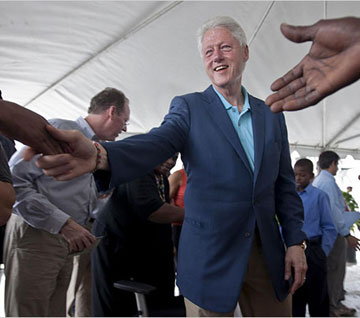 Former U.S. president Bill Clinton, now
U.N. special envoy to Haiti, glad-handing with imperialist investors at
World Bank conference in Port-au-Prince, October 2009. (Photo: Ramón Espinosa/AP)
Former U.S. president Bill Clinton, now
U.N. special envoy to Haiti, glad-handing with imperialist investors at
World Bank conference in Port-au-Prince, October 2009. (Photo: Ramón Espinosa/AP)
Today,
U.S. rulers continue to dominate the politics of Haiti and the
neighboring
Dominican Republic. Many Haitians and Haitian émigrés in
the U.S. and Canada
saw the election of Barack Obama, the first black president of the
United
States, as a promise of a brighter future. Earlier this year, United
Nations
secretary general Ban Ki Moon appointed former U.S. president Bill
Clinton as
special U.N. envoy to Haiti. Clinton, as the new colonial gouverneur,
would oversee efforts to make Haiti safe for foreign
investors. To this end he “gave his stamp of approval” to a World Bank
conference in Port-au-Prince that attracted several hundred investors
who “showed
up to network and discuss possible projects” (New York Times,
5 October), although so far without results. Simultaneously,
former U.S. president Jimmy Carter was in Santo Domingo, trying to coax
Dominican leaders into easing up on Haitian immigrants. Meanwhile,
Washington
continues to lord it over both countries, economically and militarily.
The
struggle for the liberation of the first black republic, whose working
masses
today toil in conditions of near slavery, must be international in
scope. The
fight against the “U.N.” occupation must also be waged in countries
such as
Brazil, Canada and Chile that supply mercenary troops and cops to do
the dirty
work for Yankee imperialism. Dominican workers should come to the
defense of
their Haitian class sisters and brothers, some of whom work for the
same
bosses, in common class struggle. This includes defending the rights of
the
roughly one million residents of Haitian origin in the Dominican
Republic who
are denied citizenship and persecuted by the racist rulers who create
the
climate for lynch mob terror. Above all, workers in the U.S. must
undertake
solidarity action, for the free trade zone factories are owned by or
produce
for major U.S. companies, and it is Washington that ordered the U.N.
occupation.
Neocolonial
Occupation Troops Enforce Starvation Wages
The
battle over Haiti’s minimum wage has been brewing for a long time. In
reality,
even if it were raised to 200 gourdes, it would be less in real terms
than it
was 20 years ago (adjusted for inflation). Everyone
agrees that it is impossible to live on such a wage, including
President
Préval, who asked in a June 17 letter to legislators: “Would 200
gourdes let
you live as one should? I say no, if you take into account the price of
transportation, housing, school, and so on.” The issue became heated
with the
passage of the HOPE (Haitian Hemispheric Opportunity through
Partnership
Encouragement) Act by the U.S. Congress in December 2006 and the HOPE
II Act
two years later. This trade preference provides for duty-free import to
the
United States of apparel assembled in Haiti from cheap Asian yarns,
fabrics and
components. But there is a price advantage only if wages in Haiti’s
factories
stay below Asia’s lowest-wage country, Bangladesh.
Last
December, Steven Benoit, a parliamentary deputy from the middle-class
suburb
Pétion-Ville and former member of President Préval’s
Lespwa (Hope) party, took
up the issue of the 200 gourde minimum wage. After much travail he
managed to
push the law through the Senate and Chamber of Deputies, with unanimous
or
near-unanimous votes in both houses of the legislature. When business
leaders
loudly objected that they would go bankrupt, Benoit asked to see their
tax
returns. Lo and behold, the companies had filed phony reports claiming
to be
losing money five years in a row even as they were investing to expand
production. How many jobs had been created with the present low minimum
wage,
he asked, to no avail. TV spots opposing the higher wage suddenly
appeared from
unknown and well-financed “associations of the unemployed.” A
“Dominican
industrialist” declared on television he couldn’t afford to pay Haitian
workers
$5 a day even as the Dominican government passed a law for a $9 daily
minimum
wage.
With
the hypocrisy of the capitalists and the Préval government
exposed, the issue
of the minimum wage galvanized opposition in all sectors of Haitian
society.
Since early 2009, students in several faculties of Haiti’s State
University
have been mobilized to protest the neglect of public higher education
under the “neo-liberal” policies implemented by the government and the
policies
of university authorities, as well as supporting the demand for a
minimum wage
of 200 gourdes. After the occupation of the offices of the school of
education
in late February/early March, students at the faculties of ethnology,
law and human
sciences joined the struggle. Most recently, students in the school of
medicine
and pharmacology have repeatedly occupied their faculty, and been
expelled by
mobilizations of various elite police units – CIMO, SWAT and BIM – with
dozens
of arrests. A coalition of peasant groups, 4 G Kontre, and peasants in
the
Artibonite region also supported the demand for 200 gourdes.
On May 1, workers in Batay Ouvriye (Workers Struggle), public sector workers (CTSP), peasants in the Tèt Kole Ti Peyizan (small peasants association), and women’s groups demonstrating for the minimal demand of a 200 gourde minimum wage were repressed by the CIMO riot police. As protests heated up, the “blue helmet” U.N. “peacekeepers” have come to the rescue of the Préval government as it enforces starvation wages. On June 18, during a funeral march for Father Gérard Jean Juste, a popular priest of the Tit Leglize (“little church”) liberation theology movement, Brazilian MINUSTAH troops opened fire on the crowd of Lavalas supporters, killing a young man from the Delmas slum, Kenel Pascal. The spokeswoman for the U.N. mission in Haiti justified repression against the march by denouncing UEH student protesters as casseurs (window smashers) who must not be allowed to “attack private property” (AlterPresse, 18 June). In mid-July, U.N. troops used tear gas against a student demonstration.
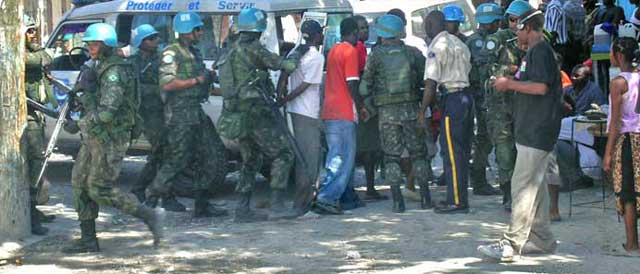
Mass arrests by Brazilian MINUSTAH troops, Village de Dieu, Port-au-Prince, February 2008. Military
police use same “counterinsurgency” tactics in poor areas of Rio de Janeiro. Brazilian Trotskyists
demand: drive Brazilian troops out of Haiti and out of the favelas! (Photo: Jean Ristil/HaitiAction.net)
Then
on August 5, MINUSTAH troops killed another young man, Ricardo Morette,
and
wounded a dozen as the “blue helmets” took down barricades of
demonstrators
protesting the lack of electricity in the town of Lascahobas. Until
recently
these mercenary troops for U.S. imperialism had concentrated on
“pacifying” the
400,000 residents of the slums of the capital, Port-au-Prince. This led
to a
series of massacres in Cité Soleil, Bel Air and other
impoverished areas in
2005 and 2006. As our comrades of the Liga Quarta-Internacionalista do
Brasil
(LQB) have pointed out, Brazilian troops are using the same
“counter-insurgency”
tactics in Haiti that are employed by military police against residents
of the favelas (slums) of Rio de Janeiro. This
is confirmed by Brazilian journalist Pedro Dantas who reported, “Army
sources confirmed
that techniques employed in the occupation of the Morro da
Providência favela are the ones Brazilian
soldiers
use in the United Nations peacekeeping mission in Haiti” (O
Estado de S. Paulo, 15 December 2007).
Some
Brazilian leftist groups have politely urged the Brazilian government
to
withdraw from Haiti, while expressing “full understanding” for the
troops faced
with the “difficulties” of their mission and dismissing Haitians
resisting the
MINUSTAH as “organized gangs linked to drug trafficking” (Causa
Operária, 22 October 2004). In contrast, the LQB and its
trade-union supporters in the Comitê de Luta Classista denounced
Brazilian
president Lula as Washington’s “sheriff” in Latin America and called on
Brazilian workers to “aid the Haitian working people in expelling the
invading
Brazilian troops.” A motion introduced by the CLC with this call was
passed by
the Rio teachers union, SEPE, and by the national teachers union, CNTE
(see
“Drive Brazilian Troops Out of Haiti!” The
Internationalist No. 20, January-February 2005). Five years after
the U.N.
forces began patrolling Haiti, now that Haitian workers and students as
well as
slum dwellers have confronted the MINUSTAH forces over the minimum
wage, it is
high time for a class mobilization to
throw out these mercenary enforcers of
starvation wages.
Lynching
and Persecution of Haitians in the Dominican Republic
While
Haitians are rounded up and shot down by imperialist henchmen “at
home,” next
door in the Dominican Republic right-wing forces have been whipping up
racist
hysteria the roughly one million residents of Haitian origin, the bulk
of whom
have been living and working there for most or all of their lives. In
2005, there
was a wave of pogroms (ethnic massacres) and the mass expulsion of tens
of
thousands of Haitians and dark-skinned Dominicans (see “Stop
Persecution of
Haitian Workers in the Dominican Republic!” The
Internationalist No. 23, April-May 2006). Since that time, the
Internationalist Group has regularly participated in monthly pickets of
the
Dominican consulate in New York City called by Grassroots Haiti. The IG
also
helped initiate an emergency demonstration in August 2008 by Dominican,
Haitian
and U.S. activists demanding an end to the deportations and racist
violence
against Haitians and opposition to the Dominican nationality law which
denies
citizenship to children of Haitian origin born in the D.R. (see The Internationalist No. 28, March-April
2009).
Now
the anti-Haitian hysteria and racial/ethnic attacks are escalating
again. The
GARR (Groupe d’Appui aux Rapatriés et Refugiés – Refugee
Support Group) has
reported a series of murders and expulsions since the start of the
year: in
January, three Haitians killed by Dominican police and several Haitians
killed
by machetes near the border; in February, 3,000 Haitian immigrants
forced out
of their homes in Santiago province and more than a hundred forced to
flee for
their lives in Higüey, as well as three more Haitians killed by
the Dominican
police; in March, a Haitian pastor and a Haitian professor at the UASD
(Autonomous University of Santo Domingo) murdered; in April, 40
Haitians
brutalized by police on a bus as they were being deported. And on May
2, Carlos
Nérilus, was decapitated with an axe in broad daylight on a
street in Santo
Domingo while a crowd applauded. Local leaders then announced they were
going
to drive all Haitians out of the neighborhood. This horrendous
execution led to
demonstrations in Haiti, and even the prime minister, Michelle
Pierre-Louis
issued a mild plea, but Haitian president Préval refused to
protest, saying it
was up to the Dominican authorities.
The
spectre of a repetition of the 1937 massacre of tens of thousands of
Haitians
in the Dominican Republic is ever-present. That slaughter by the
dictator
Rafael Trujillo was carried out with the complicity of the Haitian
government,
which profited from supplying thousands of workers for back-breaking
labor
during the zafra (harvest) on
Dominican sugar plantations, and of the United States, which set up
this system
of virtual slave labor during the 1920s when it militarily occupied
both
countries on the Caribbean island of Quisqueya (Hispaniola). Today, as
well,
Dominican sugar production depends on Haitian laborers, some imported
with the
aid of officials and governments on both sides of the border, and many
who have
lived year-round in the miserable bateyes
(slums) on the edge of the plantations. Construction projects in Santo
Domingo
also depend heavily on Haitian labor. Yet the rulers assiduously stoke
racial/ethnic hatreds even as Haitian elites spend their vacations in
the
Dominican Republic, send their children to university in Santo Domingo
and
invest their profits in the D.R.
And
despite the international publicity to the grisly decapitation of
Carlos
Nérilus, the lynchings continue. The most recent case was the
murder of three
Haitians who were shot to death, dismembered and their bodies burned in
ovens
used to produce charcoal near the Dominican border town of
Jimaní. The victims
were part of a logging operation supplying wood to this illegal trade.
While
environmentalists blame deforestation on desperately poor Haitian
peasants, in
fact it is the result of an industry run by Dominican-Haitian cartels
as
extensive as the drug trafficking mafia in this region, according to an
investigative report in the Santo Domingo daily Listín
Diario (25 October). And whether the crime was committed by
Dominican park rangers who profit from the trade, by the murderous
military
border patrol CESFRONT, or by farmers who have organized manhunts to
track down
Haitians, the ruling classes of both countries reap the superprofits
from this
deadly enterprise.
While
many of the killings have been carried out by lynch mobs of poor and
often
dark-skinned Dominicans, the racist capitalists exploit Dominican
workers as
well. Grupo M runs several garment factories with low-wage Haitian
workers in
the CODEVI free trade zone at Ouanaminthe just across the river from
the
Dominican town of Dajabón. The border there is now guarded by
the MINUSTAH,
which built a metal gate to regulate traffic. The same factory owner
has
plants in the Dominican Republic which supply the textiles and do
finishing
work on clothing produced in Haiti for chains including Old Navy, Ralph
Lauren,
Donna Karan, VF Corporation, Banana Republic, American Eagle and
Wal-Mart. Other
major corporations are the American jeans maker Levi-Strauss, with
1,600 workers
in two plants in the CODEVI industrial park, and Hanes underwear, which
produces its entire line of T-shirts there. Meanwhile, the products of
these
plants are exported to the U.S. under the CAFTA (Central
American-Dominican
Free Trade Agreement), while other Haitian plants using textiles
imported from
Asia are covered by the HOPE Act.
But
even though Dominican and Haitian workers are exploited by some of the
same
bosses, and despite the fact that they are both oppressed by Yankee
imperialism
(which sends U.S. soldiers to train the CESFRONT border troops and
hires
MINUSTAH mercenaries to patrol the Haitian side of the border), and
although
Dominican labor and left groups stage nationwide strikes and work
stoppages
annually if not more often, united action by Dominican and Haitian
workers against
their common exploiters and oppressors is almost non-existent. Why?
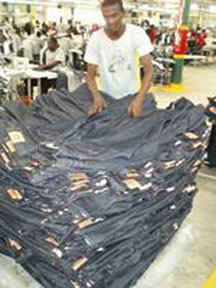 Worker at factory of Dominican Grupo M
producing Levi jeans in CODEVI free trade zone in Ouanaminthe, November
2007. (Photo: No Sweat)
Worker at factory of Dominican Grupo M
producing Levi jeans in CODEVI free trade zone in Ouanaminthe, November
2007. (Photo: No Sweat)
One
reason is the dominance of bourgeois and petty-bourgeois nationalist
politics, as opposed to proletarian internationalism,
among leftists on both sides of the border. This is a legacy of
Stalinism,
which replaced the Leninist program of international socialist
revolution with
nationalist “popular fronts” seeking (capitalist) “democracy.” Another
key
factor is the huge difference in living standards. According to a
Congressional
Research Service report on “The Haitian Economy and the HOPE Act”
(October
2008), wage levels in Haitian factories “average as little as one-third
of
those in the Dominican Republic,” while the gross domestic product per
capita
of the D.R. is ten times that of Haiti – roughly the difference between
the
United States and Mexico. Income and wage differences of that magnitude
are
difficult to overcome on the basis of simple trade-unionism, focusing
on the
struggle over the price of labor power.
Unity
of Haitian and Dominican workers will not be brought about through
reformist labor
struggles within the framework of capitalism, but only on the basis of
a
broader class struggle against the
imperialist system. The whole history of Haiti over the last century
underscores
Leon Trotsky’s perspective of permanent revolution: in the imperialist
epoch,
even the democratic tasks of the
bourgeois revolutions cannot be achieved short of the taking of power
by the
working class, supported by the peasantry, which proceeds to
expropriate the
capitalists and extend the revolution internationally. In a country
with a
numerically weak proletariat such as Haiti, throwing off the
imperialist yoke can
only come about as part of a struggle spanning borders from the island
of
Quisqueya to Brazil to the United States. And that requires above all
building revolutionary workers parties as part of
struggle to reforge the Trotskyist Fourth International as the world
party of
socialist revolution.
With
a million Dominican and Haitian immigrants
concentrated in New York City, this center of world finance capital
will be the
crucible for cohering the nucleus of such parties based on proletarian
internationalism. Just as youth from India, Pakistan and Bangladesh
have
founded common organizations here in the face of the deadly nationalism
that
has wracked their homelands, working people from the divided Caribbean
island can
make common cause in the face of the imperialist would-be masters of
the
universe who would enslave them all. As a start, the Internationalist
Group and
League for the Fourth International seek to unite Haitian and Dominican
immigrants in fighting to expel the
MINUSTAH occupation troops and police from Haiti and kick
U.S. military “advisors” out of the Dominican Republic, and to
demand full citizenship rights for
Haitians in the D.R. and for all immigrants in the U.S. ■
To contact the Internationalist Group and the League for the Fourth International, send e-mail to: internationalistgroup@msn.com